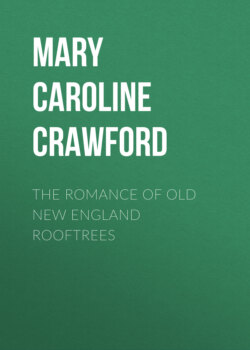Читать книгу The Romance of Old New England Rooftrees - Mary Caroline Crawford - Страница 7
На сайте Литреса книга снята с продажи.
AN AMERICAN-BORN BARONET
ОглавлениеTable of Contents
One of the most picturesque houses in all Middlesex County is the Royall house at Medford, a place to which Sir Harry Frankland and his lady used often to resort. Few of the great names in colonial history are lacking, indeed, in the list of guests who were here entertained in the brave days of old.
The house stands on the left-hand side of the old Boston Road as you approach Medford, and to-day attracts the admiration of electric car travellers just as a century and a half ago it was the focus for all stage passenger's eyes. Externally the building presents three stories, the upper tier of windows being, as is usual in houses of even a much later date, smaller than those underneath. The house is of brick, but is on three sides entirely sheathed in wood, while the south end stands exposed. Like several of the houses we are noting, it seems to turn its back on the high road. I am, however, inclined to a belief that the Royall house set the fashion in this matter, for Isaac, the Indian nabob, was just the man to assume an attitude of fine indifference to the world outside his gates. When in 1837, he came, a successful Antigua merchant, to establish his seat here in old Charlestown, and to rule on his large estate, sole monarch of twenty-seven slaves, he probably felt quite indifferent, if not superior, to strangers and casual passers-by.
His petition of December, 1737, in regard to the "chattels" in his train, addressed to the General Court, reads:
"Petition of Isaac Royall, late of Antigua, now of Charlestown, in the county of Middlesex, that he removed from Antigua and brought with him among other things and chattels a parcel of negroes, designed for his own use, and not any of them for merchandise. He prays that he may not be taxed with impost."
The brick quarters which the slaves occupied are situated on the south side of the mansion, and front upon the courtyard, one side of which they enclose. These may be seen on the extreme right of the picture, and will remind the reader who is familiar with Washington's home at Mount Vernon of the quaint little stone buildings in which the Father of his Country was wont to house his slaves. The slave buildings in Medford have remained practically unchanged, and according to good authority are the last visible relics of slavery in New England.
The Royall estate offered a fine example of the old-fashioned garden. Fruit trees and shrubbery, pungent box bordering trim gravel paths, and a wealth of sweet-scented roses and geraniums were here to be found. Even to-day the trees, the ruins of the flower-beds, and the relics of magnificent vines, are imposing as one walks from the street gate seventy paces back to the house-door.
The carriage visitor—and in the old days all the Royall guests came under this head—either alighted by the front entrance or passed by the broad drive under the shade of the fine old elms around into the courtyard paved with small white pebbles. The driveway has now become a side street, and what was once an enclosed garden of half an acre or more, with walks, fruit, and a summer-house at the farther extremity, is now the site of modern dwellings.
